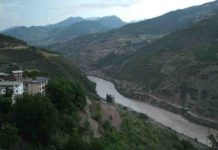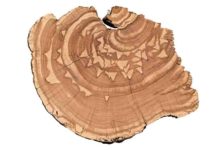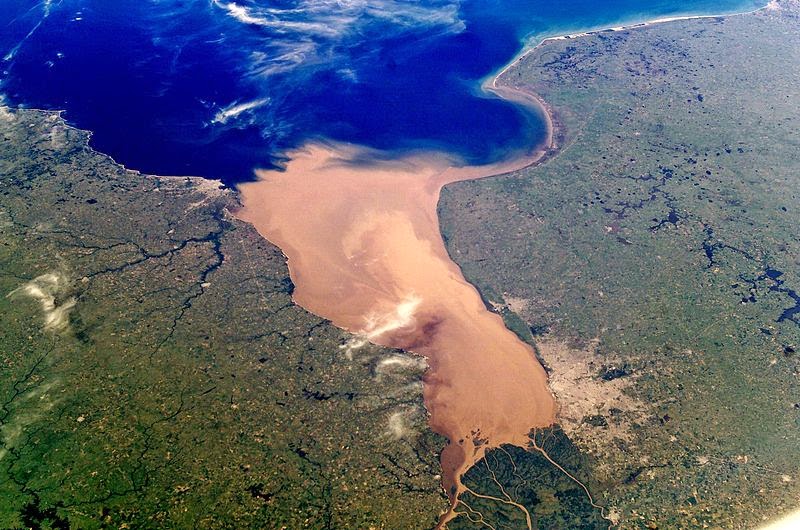
The Río de la Plata usually rendered River Plate in British English and the Commonwealth, and occasionally rendered [La] Plata River in other English-speaking countries — is the estuary formed by the confluence of the Uruguay River and the Paraná River on the border between Argentina and Uruguay. It is a funnel-shaped indentation on the southeastern coastline of South America, about 290 kilometres (180 mi) long.
The Río de la Plata widens from about 2 kilometres (1.2 mi) at the inner part to about 220 kilometres (140 mi) at its mouth. It forms part of the border between Argentina and Uruguay, with the major ports and capital cities of Buenos Aires and Montevideo on its western and northern shores, respectively. The coasts of the Río de la Plata are the most densely populated areas of Argentina and Uruguay.
Geography
Some geographers consider the Río de la Plata a gulf or marginal sea of the Atlantic Ocean, while others consider it a river. For those who regard it to be a river it is the widest in the world, with a maximum width of about 220 kilometres (140 mi) and a total surface area of about 35,000 square kilometres (14,000 sq mi).
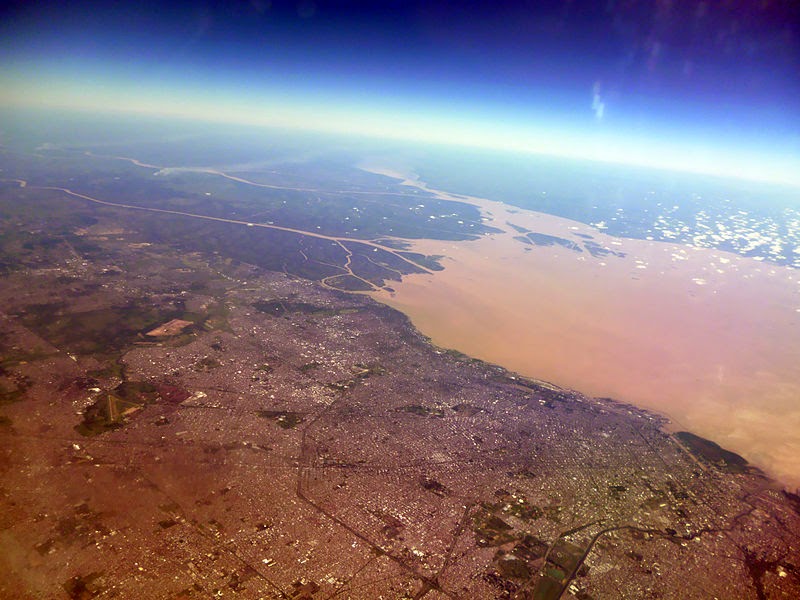
The Río de la Plata behaves as an estuary in which freshwater and seawater mix. Its freshwater comes from the Paraná River, one of the world’s longest, and its main tributary, the Paraguay River, as well as the Uruguay River and other smaller streams. Currents in the Río de la Plata are controlled by tides reaching to its source and beyond, into the Uruguay and Paraná rivers. Both rivers are tidally influenced for about 190 kilometres (120 mi). The tidal ranges in the Río de la Plata are small, but its large width allows for a tidal prism important enough to dominate the flow regime despite the huge discharge received by the tributary rivers. The rivers’ discharge is strong enough to prevent salt water from penetrating the inner Río de la Plata.
A submerged shoal, the Barra del Indio, acts as a barrier, dividing the Río de la Plata into an inner freshwater riverine area and an outer brackish estuarine area. The shoal is located approximately between Montevideo and Punta Piedras (the northwest end of Samborombón Bay). It is the freshwater of the inner area that causes many to describe the Río de la Plata as a river. The depth of the inner fluvial zone is between about 1 to 5 metres (3.3 to 16.4 ft). It is about 180 kilometres (110 mi) long and up to 80 kilometres (50 mi) wide. The depth of the outer estuary zone increases from 5 to 25 metres (16 to 82 ft).
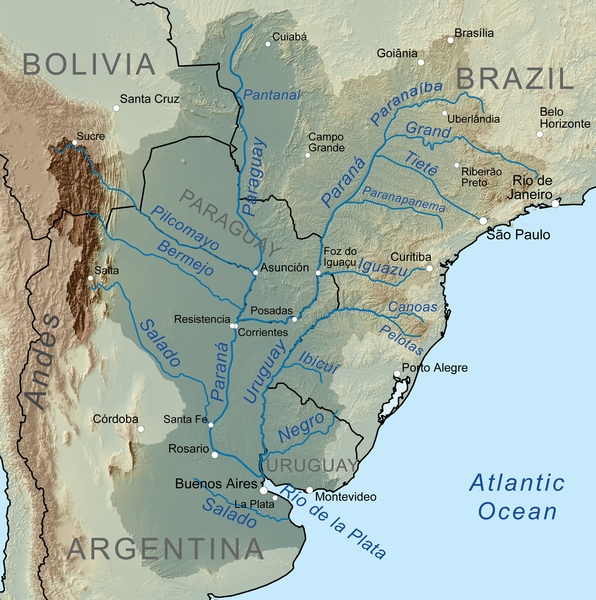
The Río de la Plata is a salt wedge estuary. Saltwater, being denser than freshwater, penetrates into the estuary in a layer below the freshwater, which floats on the surface. Salinity fronts, or haloclines, form at the bottom and on the surface, where fresh and brackish waters meet. The salinity fronts are also pycnoclines due to the water density discontinuities. They play an important role in the reproductive processes of fish species.
Extent
Drainage basin
The Río de la Plata basin is the second largest drainage basin in South America. At a size of about 4,144,000 square kilometres (1,600,000 sq mi), the basin is about one fourth of the continent’s surface. It includes areas of southeastern Bolivia, southern and central Brazil, the entire nation of Paraguay, most of Uruguay, and northern Argentina. The main rivers of the La Plata basin are the Paraná, one of the longest in the world, and its main tributary, the Paraguay River, and the Uruguay River.
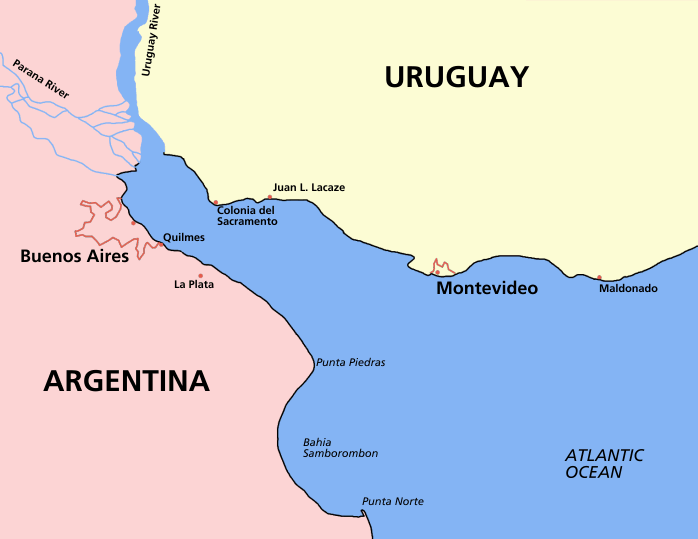
The Paraná River’s main tributaries include the Paranaíba River, Grande River, Corumbá River, Tietê River, Paranapanema River, Iguazu River, Negro River, Carcarañá River, Gualeguay River, and the Salado River. The Paraná River ends in the large Paraná Delta.
The Paraguay’s main tributaries include the Jauru River, Cuiabá River, Taquari River, Nabileque River, Curiche Grande River, Apa River, Pilcomayo River, and the Bermejo River. The Paraguay River flows through the Pantanal wetland.
The Uruguay’s main tributaries include the Pelotas River, Canoas River, Peperiguaçu River, Ibicuí River, Quaraí River, and the Río Negro.
The rivers of the La Plata Basin carry an estimated 57,000,000 cubic metres (2.0×109 cu ft) of silt into the Río de la Plata each year, where the muddy waters are stirred up by winds and tides. The shipping route from the Atlantic to Buenos Aires is kept open by constant dredging.
History
Sebastian Cabot made a detailed study of the area and renamed it Río de la Plata. He explored the Paraná and Uruguay rivers between 1526 and 1529. He ascended the Paraná as far as the present-day city of Asunción, and also explored up the Paraguay River. Trading with the Guaraní near today’s Asunción, Cabot acquired silver trinkets, and these objects gave rise to the name Río de la Plata, “river of silver”.The area was visited by Francis Drake’s fleet in early 1578, in the early stages of his circumnavigation.
The first European colony was the city of Buenos Aires, founded by Pedro de Mendoza on 2 February 1536. However, it was quickly abandoned. It was refounded by Juan de Garay on 11 June 1580. The failure to establish a settlement on the estuary led to explorations upriver and the founding of Asunción in 1537.
During the colonial era the Río de la Plata was largely neglected by the Spanish Empire until the 1760s, when Portugal and Britain threatened to expand into the estuary. The Spanish Viceroyalty of the Río de la Plata was created in 1776. In 1806 and 1807 the river was the scene of an important British invasion that aimed to occupy the area.
Conflict in the region intensified after the independence of the former Spanish and Portuguese colonies in the first quarter of the 19th century. Interests in the territories and the navigation rights over the Platine region played a major role in many armed conflicts throughout the century, including the Argentine civil wars, the Cisplatine and Platine wars, and the Paraguayan War. The river was blockaded by extra-regional powers 1838–1840 and 1845–1850.
Battle of the River Plate
In the first naval battle in the Second World War the German pocket battleship Admiral Graf Spee was engaged by the Royal Navy (RN) cruisers, HMS Exeter, Ajax and Achilles off the estuary of the River Plate. The German ship retired up the estuary with a crippled fuel system and put into port at Montevideo. A few days later, rather than fight outgunned, she was scuttled in the estuary.
Etymology
The English name “River Plate” is not, as sometimes thought, a mistranslation, as “plate” was used extensively as a noun for “silver” or “gold” from the 12th century onwards, especially in Early Modern English and the estuary has been known as the River Plate or Plate River in English since at least the time of Francis Drake. A modern translation of the Spanish Río de la Plata is “Silver River”, referring not to color but to the riches of the fabled Sierra de la Plata thought to lie upstream.
The English version of the name served as an inspiration for one of Argentina’s most important football clubs, Club Atlético River Plate.



